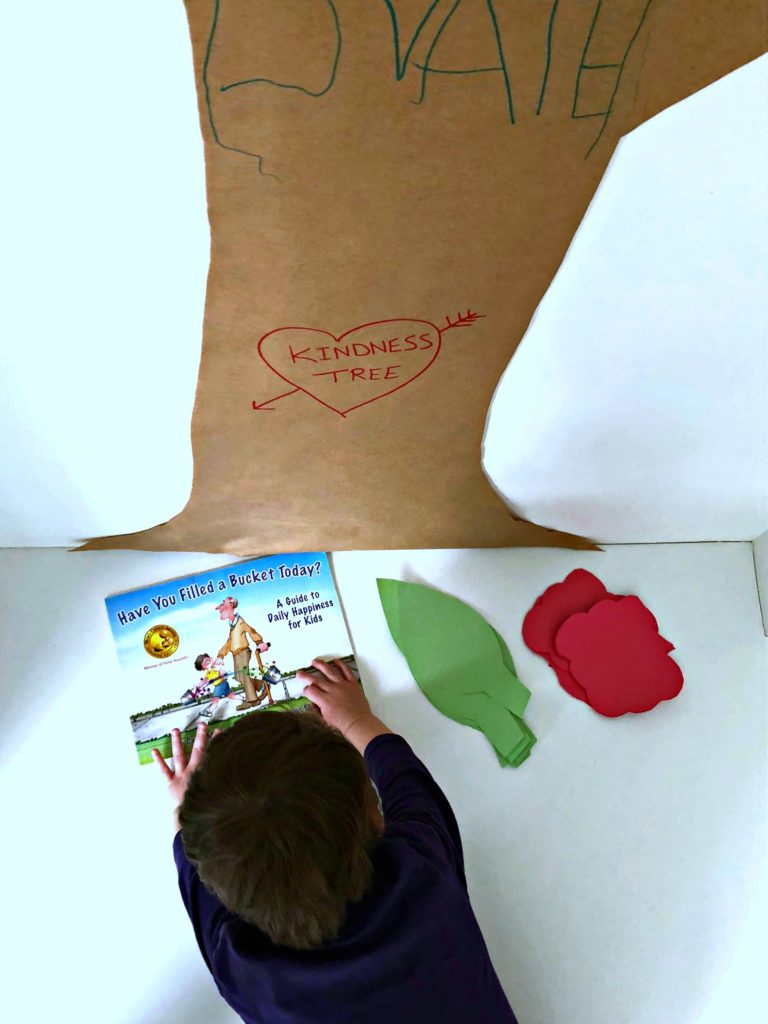I’ve always believed that the foundation to teaching any life lesson should begin at home. Kyle was just two years old when John and I implemented the “bucket” approach to kindness at home. Instead of saying “be nice” or “stop being mean” we refer to our children’s actions as either ‘bucket filling’ or ‘bucket dipping’. We came up with this idea based on the book by Carol McCloud, titled “Have you filled a bucket today?” We read this book to our kids often, so they understand the meaning of being a bucket filler (being kind, including others, and being helpful), versus a bucket dipper (being mean or a bully).

My favourite lesson from this book is that it teaches kids that if you want to fill your own bucket, the only way to do it is by filling up other people’s buckets. When you dip into other people’s buckets, you can’t use it to fill your bucket… it actually depletes your bucket more. So, to make yourself feel good and be happy, you need to make others feel happy. I find that it’s a great way to teach the concept of kindness and bullying to young kids.

While we took the time to teach our kids the importance of being kind, there are no guarantees! When kids go to school they are in a new setting and environment, with a new adult figure (aka – their teacher), and new friends. Your child’s reaction to a new situation may not be what you’ve been teaching them.
Unfortunately, bullying at school often starts when kids are still young. As kids age, the severity and type of bullying often worsens. Luckily, schools and organizations have taken notice and have implemented teaching tools like Pink Shirt Day and bullying prevention curriculum to help draw awareness to this important issue.
On average, bullying tends to stop within 10 seconds after bystanders intervene.
Shaw Communications is also supporting bullying prevention by empowering students to come up with ideas for making kindness stick at their school. Those selected will receive grants of up to $5,000 to turn their idea into reality. From now until April 30, students from across Canada can apply to earn 1 of 10 grants to bring a positive initiative to life in their school. Get the full details on the program and complete your application here.

Shaw’s idea of making kindness stick has really struck a chord with me and has given me an idea to start a fun project with my own kids at home. Like I said, life lessons always start at home and there’s nothing like siblings to bring out the best (and the worst) in you. While common, my boys definitely struggle the most to be kind to one another. I figured that with a little creative encouragement, perhaps I can get my kids to act kinder to each other. I decided to make a kindness tree and display it proudly on our main floor. Our kids are encouraged to come up with ideas how they can be kind. They can report back to us about an instance when they did something kind that day and write the example on a leaf or a flower that we then stick to the tree. The kids love seeing how many leaves or flowers they have up with their names on it (a little friendly competition). As a parent, I’ll often ‘refresh’ their memory when they are not behaving well about their promise to be kind by pointing back to the tree.

Just like the Shaw Kindness Sticks Grant program, I’m hoping to make kindness stick with my kids at home and at school!

Thought starters and general information for Shaw’s Kindness Sticks initiative
Parents – now it’s your chance to encourage your child to take the lead and make a difference in their school. Work together with your child and get them to apply for this amazing program that will make a big difference in their life, school and community!
Maybe your child wants to start a Kindness Tree at their school? Every week or month, kids and teachers can select a student in the class that best exemplified kindness and a flower or a leaf can be placed on the tree detailing why they were chosen.
Other examples of potential project ideas include:
- Kindness Sticks mural
- Bullying prevention event
- Book about bullying featuring work from students
When submitting your project, just make sure you’ve answered the following questions:
- How does my project contribute to a positive school environment?
- What kind of budget does my project need?
- How can people volunteer and get involved to make my project come to life?
- Who does my project impact and reach?
- How is my project creative and unique?

What are some of the ways you teach your children about kindness and being inclusive?
Disclosure: This post was sponsored by Shaw Communications. I received compensation in exchange for this post. All opinions are my own.

I love this post!
Love that book, will have to find it to share with the nephews.
For us, we speak plainly about the reasons to be kind and hold those around us in high regard. I don’t know if it’s working, ’cause as you mentioned, school concepts and interactions are something that needs to be factored in.
What I do know is that we have two kids that are eager to help in chores, making meals, and are frequently asking their loved ones if they had a good day. They make me smile, lol.
It’s so awesome that Shaw created a grant for kindness! Every little bit helps!
What a great concept, and a fun way to teach it with that book! I love it! I love that the grant encourages kids to come up with the ideas on their own, too!